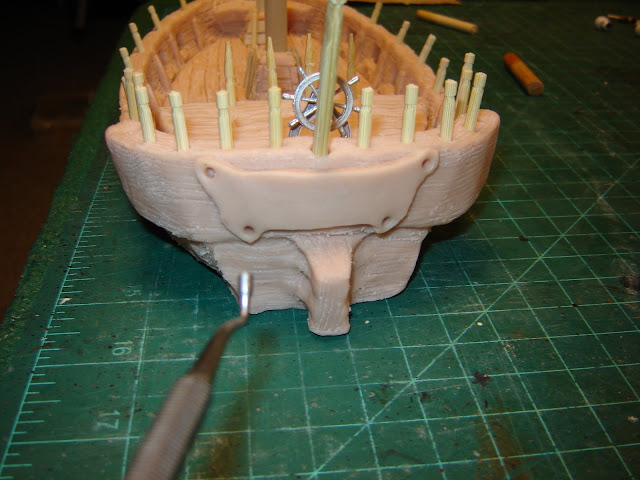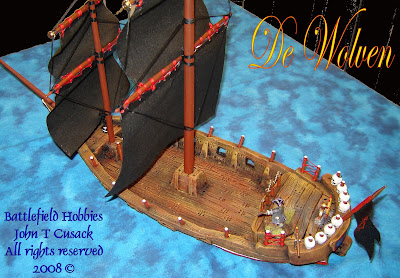Prime and paint the ship.
In this installment I will cover the steps required to prime and paint your Pirate Ship model.

Preparing the model:
Once the model is fully cooled after baking, you will need to take a few minutes to clean up the model.
- Remove the temporary mast, and test fit the permanent mast. You may need to drill out the hole a bit, but do not enlarge the hole. Later you will slightly tapper the bottom of the mast.
- Remove and glue any loose posts, on the gunwales, allow time to dry before priming. Use Allene's Fast Grab Tacky Glue for best results.
- Remove the mast support posts, assuming they are loose. My support post had been loose, so I opted to set them aside in a egg cart like storage container.
- Remove the Captains wheel and set aside. Remove the wheel stand if it is loose, if you used string as I did, it should not be loose. Take care not to paint it too much with the base coat.
- Sand the bottom of the model if any wood pieces are showing.
- Clean any rough clay, as a result of the wood grain effect. Do this by running your fingers across the model surface. You will find that little tiny pieces of clay will come loose. You do not need to use tools or sand paper for this step.
With very little effort the removable quarterdeck should come loose. You may need to use a fine edge clay knife along the seams. Do this very carefully taking your time. Hopefully you will not need to cut to free up the quarterdeck area. If you must cut, be carefully not to snap the exacto blade, Sculpey is stronger then you may guess.
Test fit the deck guns:
Test fit your deck gun at each gun port. Mark any areas that need filing. File any gun ports as needed. Again, hopefully you will not have to cut or file too much.
Prime the model:
 Let any glue dry as required.
Let any glue dry as required.Use acrylic paint to prime your model. I prefer black, applied with a large stiff bristle brush. You may use spray flat acrylic if you like, however make sure you have proper ventilation and a painters mask.
Prime the model and allow time to dry. I generally allow the model to sit overnight.
Spot prime as needed:
 Inspect the model and spot prime any areas that are not fully covered. You want the black to fully cover all those little cracks and rivets.
Inspect the model and spot prime any areas that are not fully covered. You want the black to fully cover all those little cracks and rivets.Allow to dry as needed.
=> Note the storage container that holds the wheel, bow spar, flag staff, and support posts for each of the masts.
Select your color scheme:
Select your ships color scheme. For example, a Ghost ship could be gray and weathered, a Naval war ship could be very well kept, with fresh bright colors.
Pirate ships as a rule, would fall somewhere in between. I like to make most pirate ships, "fairly" well kept, yet showing signs of wear and tear or even some battle damage.
I have selected to have this ship, well kept with a darker blend of wood and bright highlights to contrast the dark wood. Dark sails and red and black rigging, with the custom Wolf artwork on the sails.
Apply the Base coat:
 As a general rule, most artists will not start with models finish color. In fact, most artist will agree that you should begin two or three shade darker. With a black primer, by intent I must apply more coats to bring "light" back into my model. The contrast of light and dark is what gives your model life.
As a general rule, most artists will not start with models finish color. In fact, most artist will agree that you should begin two or three shade darker. With a black primer, by intent I must apply more coats to bring "light" back into my model. The contrast of light and dark is what gives your model life.I selected Burnt Umber as my base coat.
Using a dry brush, touch the edge of your paint and then apply the base coat on the hull and decks. Do not try to cover every rivet hole and crack, most of the little cracks and rivets should remain black. Let the model dry!
Dry Brush:
Using your base coat again, dry brush the model. Keep the brush dry and hit only the main surface areas. Since your first base coat had to overcome the black primer, using the same color for a second coat will make the model appear as if you used a lighter color. Let dry!
Detail posts and supports:
=> You can later add details to the posts and support if you wish to have the support pieces stand out from the wood of the main deck.
Prepare the Bow Spar:
 The bow spar and flagstaff should be lighly snaded before painting them. Appling paint even in thin layers will make it dificult later to insert and remove the bow spar. It is best to sand the tappered end now, then apply the prime and base coat.
The bow spar and flagstaff should be lighly snaded before painting them. Appling paint even in thin layers will make it dificult later to insert and remove the bow spar. It is best to sand the tappered end now, then apply the prime and base coat.=> Often times I use a different base coat on the flag staff and bow spar. In this case the base coat is Red Iron Oxide, applied with an even coat of paint.
Add a lighter shade for highlights:
 At this point, your model should have dark areas and some that are visually lighter. I have used a Red Iron Oxide to lighten the model. First with a mix of Burnt Umber, then a second coat with just Red Iron Oxide, applied with a very dry brush. Burnt Sienna works good too in place of Red Iron Oxide.
At this point, your model should have dark areas and some that are visually lighter. I have used a Red Iron Oxide to lighten the model. First with a mix of Burnt Umber, then a second coat with just Red Iron Oxide, applied with a very dry brush. Burnt Sienna works good too in place of Red Iron Oxide.Again keep the brush dry. Both coats are only lightly dry brushed on the main deck areas, the bow and top edges of the hull.
 Let dry.
Let dry.With the dry brush method, you should not have to wait long for the model to dry
The next coat is with Yellow Oxide, using a very dry brush. This final dry brush only hits the fine edges of the model.
=> It should dry very quickly this time, so you will only have to wait a few minutes.
Detail Paint:
 I have detailed a high water line along the base of the model, Bright Red, which a common color used on the hull. You can even trace a white line for effect above the red hull paint.
I have detailed a high water line along the base of the model, Bright Red, which a common color used on the hull. You can even trace a white line for effect above the red hull paint.=> Black looks good for the hull too.

Add any fine details to highlight or enhance the character of your model.
Notice the Skull door knob, and light blue port holes. The color in the port holes give the illusion of glass, with reflected white clouds in the windows. Also i painted the hinges iron, and painted the fittings on the guard rail and port holes as brass.
 Detail the posts by painting them a solid color, I use Red Iron Oxide, then applied a white finish on the top of each post.
Detail the posts by painting them a solid color, I use Red Iron Oxide, then applied a white finish on the top of each post.- Optional black-wash: Many artist like to black-wash their models. This is done with a drop of black acrylic or for the experienced with black ink. The black is mixed with very generous amount of water. I will cover this technique in a separate blog in the future. It is easy to lose the bright colors on your model if do it incorrectly. I would suggest Not black-washing the model at this time. You can always do it later. I did NOT black-wash this model.
= > You will notice how applying several coats gives the model the look of a real wood deck, with some areas shaded and others highlighted.
Concluding part 9:
This concludes part NINE of the Pirate Ship project.
In the next installment I will cover how to make masts and sails, then how to add the rigging to your ship.
You are close to completion, and your hard work and patience should show within the details of your ship.
John T Cusack
Www.battlefieldhobbies.org













































